Drive business transformation with AI in Accounts Payable
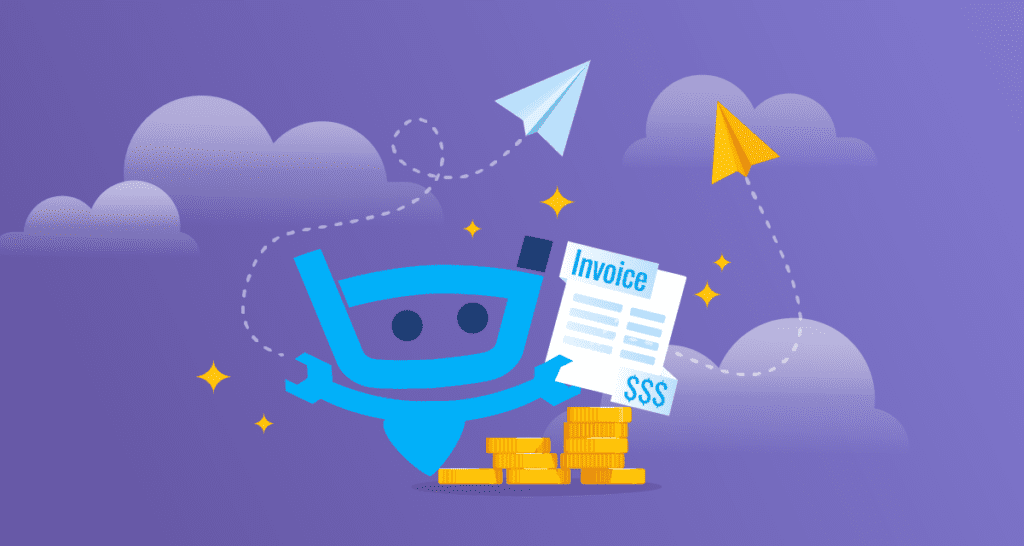
How can AI–powered accounts payable automation transform your business?
Artificial intelligence is the biggest story in business today, and finance leaders are taking notice. According to Deloitte’s Q4 2023 CFO Signals report, 80% of CFOs say they will embed more automation/digital technologies into finance operations in 2024.
It’s no surprise why. Case studies show that AP automation reduces costs, increases workflow efficiency, and improves cash flow management.
In this article, we’ll explore the benefits of using AI in Accounts Payable, what AP processes AI can improve, and best practices for implementing AI in your accounts payable department.
What are the benefits of using AI for AP?
AI-powered accounts payable automation uses algorithms and machine learning to eliminate and optimize manual processes. By mimicking the decision-making and problem-solving capabilities of the human brain, AI can take on complex and repetitive tasks, like intelligent document processing or invoice coding.
AP automation is at the forefront of the digital transformation of finance functions in business. In a recent survey by Stampli and Probolsky Research, 89% of CFOs and other finance leaders said they want to adopt AI for accounts payable functions. And in their 2023 Pulse Survey, PWC reported that 45% of CFOs plan to invest in AI solutions in the next 12-18 months.
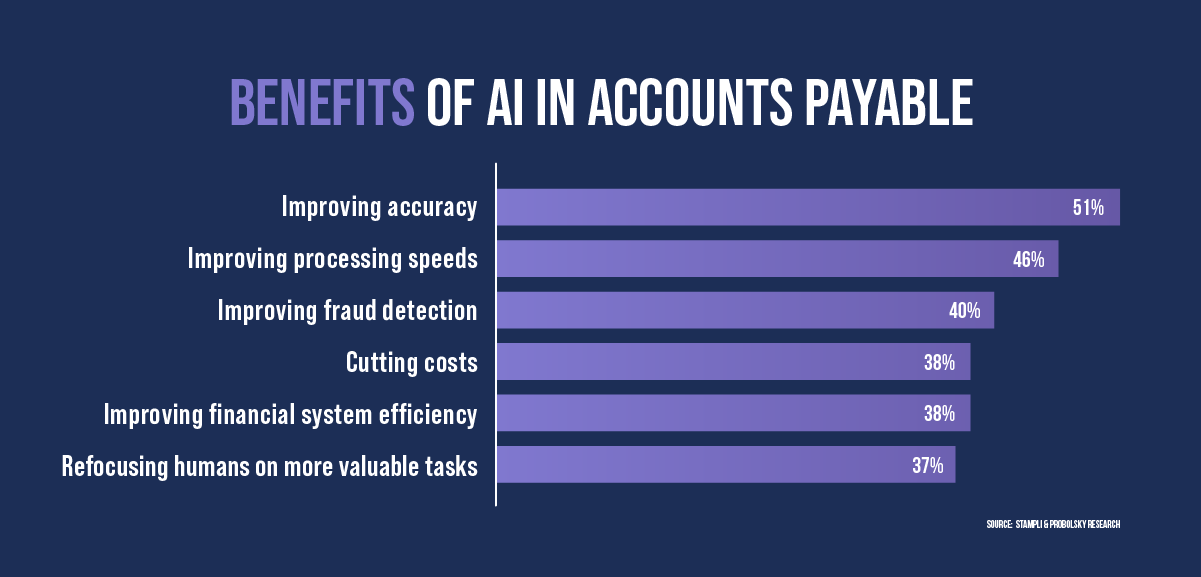
How does AI optimize the accounts payable process?
AP automation solutions use various AI technologies to scan and enter documents, interpret and act on data, learn AP processes, enforce internal controls, and route invoices for payment processing. We’ll talk more about specific applications, but first, let’s look at the benefits of implementing AI in Accounts Payable.
Better accuracy and compliance
Because AI–powered AP solutions learn as they go, they become more accurate with every invoice they process. Greater accuracy helps your business comply with tax laws and reporting requirements and gives more transparency and control over spending.
Human errors in accounts payable, such as misplaced invoices, incorrect data entry, and duplicate payments, can lead to significant financial losses. Sophisticated AI algorithms can help prevent such errors by processing invoices accurately.
Better processing speeds
Invoices are becoming more complex, and so is the job of processing them. That’s because they contain unstructured data that doesn’t have a set format and can’t easily be read and processed by machines. As a result, invoice entry has typically been a manual process. AI-powered AP solutions use machine learning technology to learn how to process unstructured data and perform complex tasks like invoice processing. They can also process other forms of unstructured data like PDFs, emails, text messages, purchase orders, and contracts.
Improved fraud detection
AP automation solutions provide several powerful fraud detection functions.
First, AI solutions centralize AP processes, which provides greater visibility of the end-to-end AP workflow. They also include security features like multi-factor user authentication and data encryption to protect critical data.
Second, AI platforms include anomaly detection functionality that analyzes invoice patterns and flags potentially fraudulent information. It can find errors and evidence of fraud, like slight differences in invoice details or duplicate line items, that human employees can miss.
Third, AI platforms automate two and three-way matching to detect duplicate invoices and discrepancies between purchase orders and invoice data.
Reduced costs & improved and cash flow
AI-powered processing is faster and more accurate compared to manual processes. This results in significant time and cost savings for businesses. Additionally, faster processing enables quicker supplier payments, which helps to reduce late payment fees and allows for early payment discounts.
Better financial system efficiency
Automated invoice processing enables easy access and analysis of real-time transaction data, automates data syncing with ERPs, accounting software, and other business applications, and facilitates informed decision-making.
Refocusing staff on high-value tasks
One of the greatest indirect benefits of AI-powered AP automation is that it frees accounts payable teams from tedious manual work so they can work on higher-value tasks. It’s a benefit that’s not lost on CFOs. In Deloitte’s Q4 2023 CFO Signals, 81% of CFOs reported they will use automation technologies to “free people to use their talents for higher-value activities” in 2024.
With these benefits in mind, let’s explore which AP functions you can optimize with AI.
AP tasks you can automate with AI
You can use AI to automate AP processes in two ways:
- Automating the end-to-end invoice processing workflow.
- Automating AP financial, administrative, and reporting tasks.
Let’s start by looking at how AI optimizes invoice processing.
Automating the end-to-end invoice processing workflow
AP automation replaces manual invoice processing workflows by automatically capturing and classifying unstructured invoice details from digital and paper invoices, validating invoice information, and routing invoices for approval.
Accounts payable software with machine learning algorithms automatically learns your organization’s invoice processing rules. It can recognize and extract invoice details to classify and route them automatically. It can also categorize vendor invoices based on historical patterns without human assistance, allowing finance teams more time for strategic tasks.
While many businesses have adopted partial automation in AP workflows, such as invoice scanning, this piecemeal approach often results in fragmented processes and data silos. Full AP automation streamlines the entire end-to-end workflow, ensuring seamless process integration.
Here are five ways AI optimizes a typical AP workflow.
Invoice data capture
AP automation software uses optical character recognition to quickly and accurately scan and digitize invoice data, including invoice numbers, vendor names, prices, PO numbers, line item descriptions, and taxes. The software can handle multiple invoice formats, eliminating the need for slow manual data entry and avoiding backlogs or late payments.
Data extraction
After scanning the invoices, the software uses NLP technology to understand, extract, and classify the invoice data accurately. For example, it can identify and extract header data like vendor name, due date, amount due, and payment terms and line item information like product descriptions, unit prices, and quantities.
If the software is unsure about the accuracy of the invoice details, it will flag it and send it to an AP team member for a manual check.
General Ledger (GL) coding
After the software extracts and classifies the invoice data, it uses machine learning to assign GL codes to the line items. If it comes to an item where it’s unsure of the code, it will make a suggestion and flag the code for a member of the AP team to confirm. The software also learns from your historical patterns to determine if a line item needs a special GL code. For example, it can assign GL codes by department, project, or category.
2 and 3-way matching
Once the software has GL-coded the invoice data, it can perform two or three-way matching to check the accuracy of the invoice. To do this, the software finds the right purchase order and shipping documents and checks the details to ensure they match. If they do, it forwards the invoice for approval. If they don’t match, it flags the discrepancy for the AP team to investigate.
Approval routing
When the software verifies the invoice is accurate, it routes it to the appropriate approver (or approvers) for approval. Over time, the software learns your company’s approval process based on financial policies and past invoice approval history. For example, it can look at the invoice amount or vendor name and know which approval chain the invoice must follow.
The software can also follow up with approvers within a certain period to remind them of invoices sitting in their approval queue to get invoices approved on time.
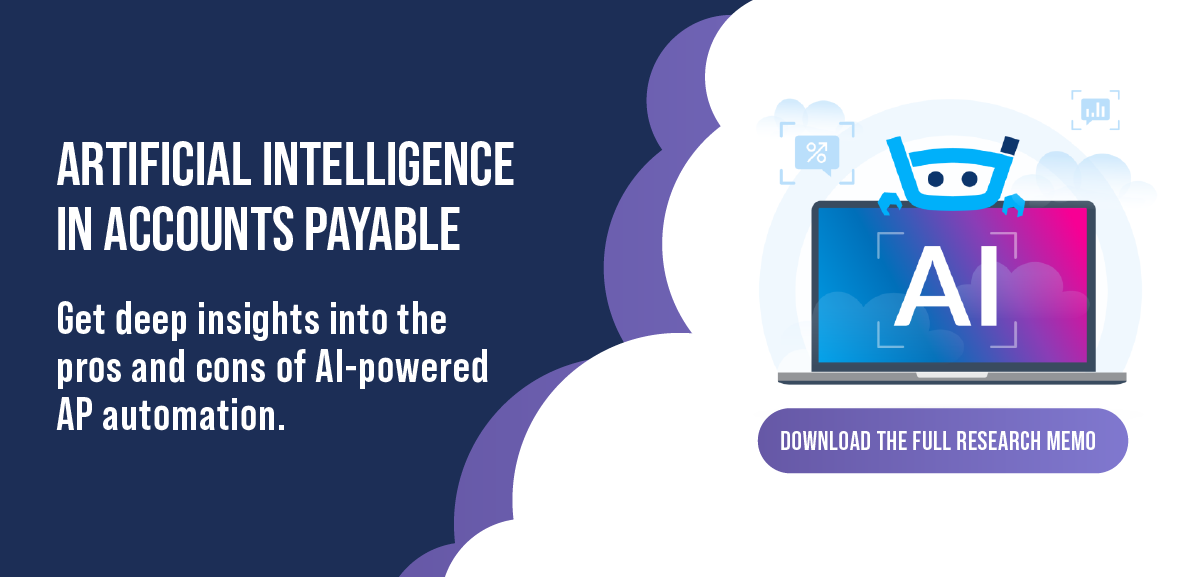
Automating financial, administrative, and reporting tasks
Alongside invoice processing, AP automation optimizes core accounts payable tasks and processes.
AP reports and dashboards
AP software can provide accurate, real-time insights, KPIs, forecasts, and analytics about AP team performance, invoice aging, Days Payable Outstanding, and other financial metrics. This information lets CFOs and finance leaders make informed working capital management and strategic decisions.
Sanctions screening
Manual sanctions screening processes can put your business at risk. AP software can automate sanctions screening processes such as OFAC searches to ensure your business is protected.
Compliance and audits
AI software can automatically keep a complete audit trail of the actions and communications in the AP process. This mitigates the risk of internal fraud, ensures data integrity, and reduces AP employees’ workloads during tax season.
Vendor onboarding and compliance
AI software can facilitate self-serve vendor onboarding by screening new vendors and automating vendor data collection. Also, the software can ensure vendors have provided key documentation like contracts, insurance policies, and licenses – and keep these documents up to date by reminding vendors to upload current versions when old ones are expiring.
Best practices for using AI-powered AP automation
Moving to AI-powered invoice processing can transform your business. However, like with any change, there are potential hurdles to overcome to ensure a successful implementation. Before implementing an AI-powered AP solution, look at your existing P2P workflows to identify tasks and areas where automation could benefit your business. This can include bottlenecks, critical tasks like invoice matching, and repetitive, error-prone processes.
Here are some best practices to smooth your implementation and get optimal performance.
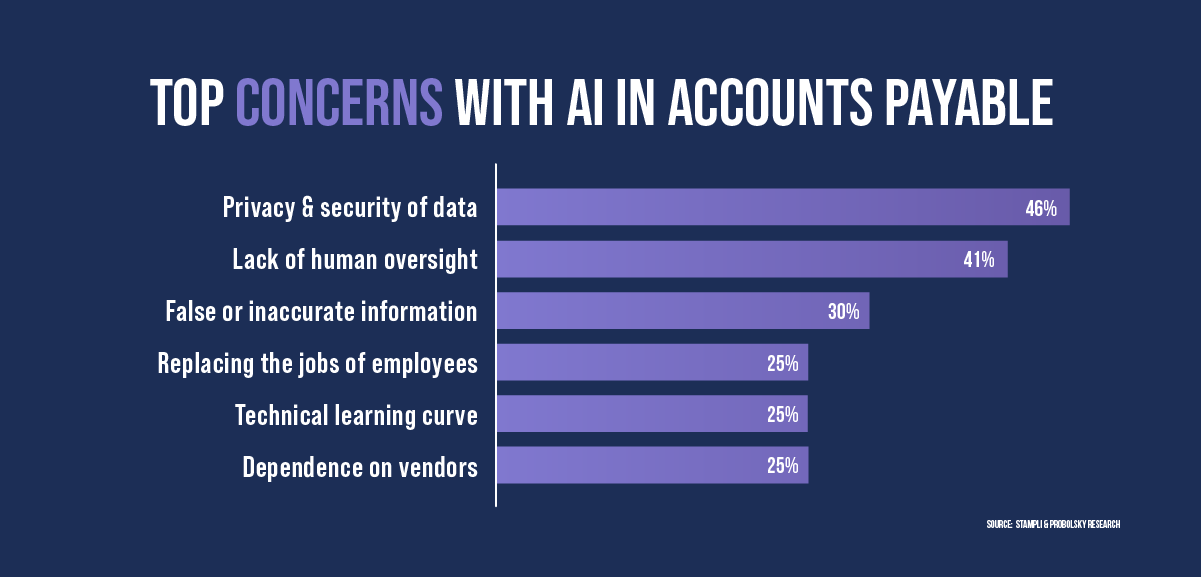
Trustworthiness & security
An AP automation system will handle sensitive data like vendor information, prices, and financial data. Ensuring the system is secure and compliant with regulatory requirements is crucial.
AI-powered solutions must be reliable and transparent. Hallucinations, errors, and incorrect decisions could cost your business money due to erroneous payments, exposure to fraud, or liability. Carefully vet any AI invoice processing solution to ensure it’s secure and trustworthy.
Keep a human in the loop
Many common objections to adopting AI accounts payable automation focus on the human/machine relationship. In the Stampli and Probolsky Research survey, many stakeholders expressed concerns about AIs replacing jobs, a lack of human oversight, and a steep learning curve.
These results suggest that integrating human decision-making into AI solutions and ensuring all stakeholders understand the benefits of AP automation could make it easier to implement a solution.
You can also prevent expensive mistakes by keeping a human in the loop. AI automation can dramatically improve invoice management workflows but can only do some jobs. When you review your current workflows, identify tasks that need human intervention or supervision. For example, it’s advisable to have a responsible employee approve invoices and supplier payments.
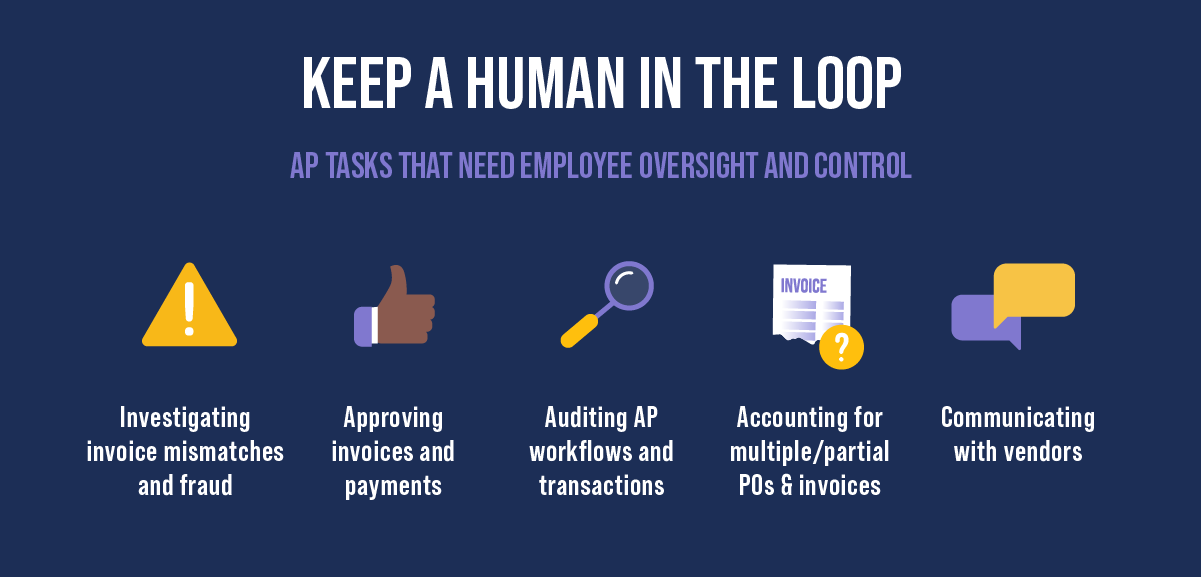
Test & monitor the solution
After implementing your AP automation solution, testing it to ensure it works properly is crucial. Your testing plan should include manual and automated testing to identify and address any issues. Additionally, monitor the system’s performance once it’s operational and make any necessary adjustments to improve its efficiency and accuracy.
Integrate with ERPs and business systems
Integrating your accounts payable automation software with enterprise resource planning (ERP) and accounting software enables you to share data and communication with all members of your organization. When evaluating an AI-powered invoice management system, make sure it provides effortless API integration with your current business systems.
Choose the right AI invoice processing provider
When choosing an AI-powered invoice processing solution, it is important to consider several factors. Look at the IT requirements, functionality, cost, and efficiency of the solution, as well as other important factors such as customer service, implementation time, scalability, and user-friendliness. You can find helpful resources and reviews on sites like G2 to aid your search.
AI-powered invoice processing is a rapidly evolving technology that is becoming more powerful and flexible. By following the tips and advice in this article, you can simplify your AP workflows and transform AP into a strategic engine for your business.
Stampli: The leader in AI-powered AP Automaton
Stampli is the only AI-powered AP automation solution designed for Accounts Payable. It centers communication, documentation, and workflows on top of each invoice, eliminating the need for workarounds, external communications channels, 3rd-party solutions, or manual AP work inside the ERP.
Stampli gives your AP team full visibility into the status of every single invoice and payment. Every activity in Stampli is logged and auditable, making month-end close simple and efficient.
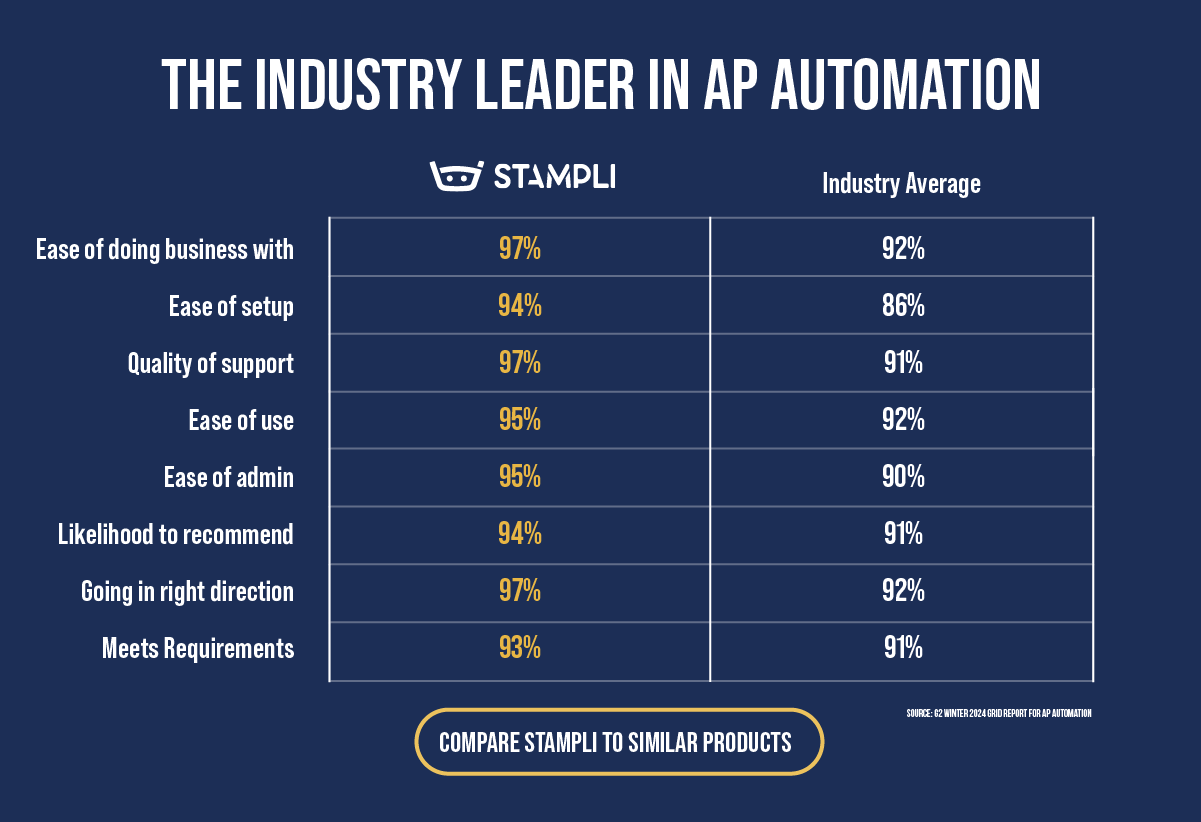
Billy the Bot
Manual processing isn’t just boring and time-consuming — it holds teams back from more strategic initiatives. Billy the Bot, Stampli’s AI assistant, takes over these responsibilities while you and your team focus on the work that truly moves the business forward.
Billy is a powerful AI designed to automate the manual aspects of the entire invoice lifecycle. For example:
- Once a Stampli customer receives an invoice, Billy codes key data from the document — vendor name, date, location, line items, quantities, and more.
- Billy auto-codes the invoice to the correct general ledger accounts, ensuring accurate financial reporting without manual classification.
- Billy auto-detects duplicate invoices so you don’t accidentally pay vendors twice or waste time figuring out if it was already processed.
- Billy looks at discrepancies between the invoice and PO total amounts. Billy knows when to skip approvals for an invoice if it’s a match.
- Billy recognizes company policies to determine appropriate people for approval routing.
- As invoices go through approvals, Billy tracks their status and sends timely reminders to prevent bottlenecks.
Billy saves money by helping AP teams handle 30-50% more work volume without expanding headcount. Working with Billy eliminates the frustrating scramble of hunting down invoices, coding, and chasing approvals. With Billy’s help, AP teams focus on strategy, exceptions management, and value-added analysis rather than wasting skills on repetitive manual tasks.
Give Stampli a call and see what Billy can do in partnership with you.